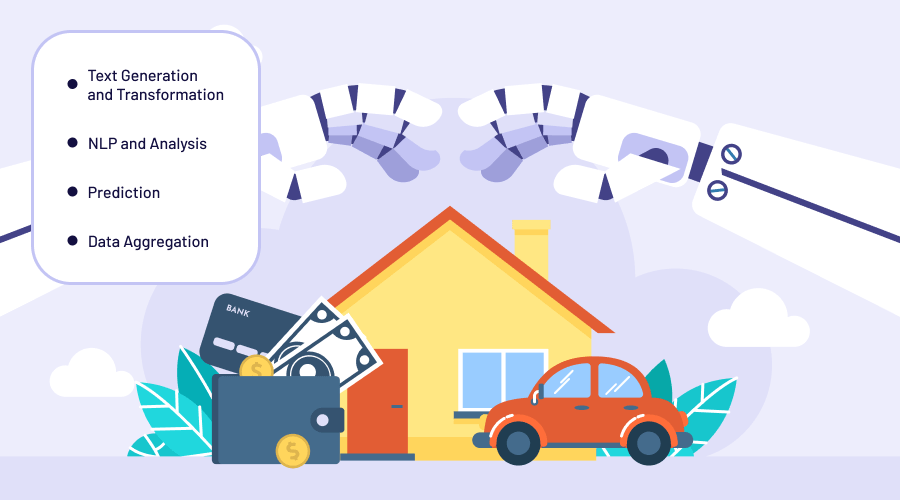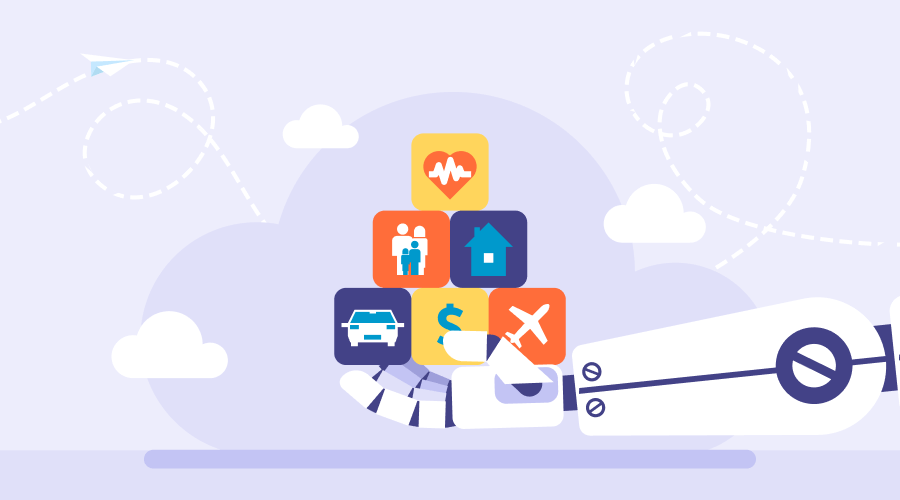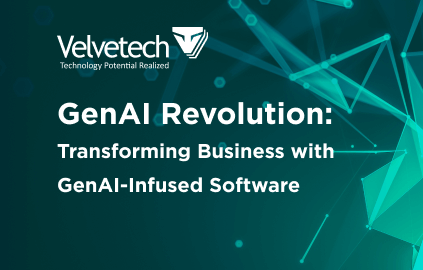Insurance is one of the spheres where reliability, precise analysis, and efficiency are key requirements for success. Following the rapid development of generative AI, this industry stands to gain tangible benefits from its application.
This article offers vital insights into the ways generative artificial intelligence is currently transforming the world of insurance services. Among other things, we look at the advantages of generative AI over traditional methods in insurance, integrating generative AI into insurance workflows, and its effect on customer satisfaction.
SWOT Analysis of Generative AI for Insurance
GenAI solutions have been steadily carving a bigger and bigger niche for themselves across various markets and business spheres, such as marketing, healthcare, and engineering. The benefits of using generative AI for the insurance sector include a boost in productivity, personalization of customer experiences, and many more.
Take a look at How Healthcare Companies Use GenAI
However, like any other powerful tool, generative artificial intelligence has its disadvantages. Our analysis below targets the potential challenges of integrating generative AI in insurance, together with its main advantages.
Strengths: Generative AI Functionality

Generative AI refers to a type of artificial intelligence that has the ability to create new materials, based on the given information. This is especially valuable for all text-based work in the insurance domain.
How does generative AI improve insurance software and processes? There are five key tasks that genAI can positively impact.
Text Generation and Transformation
Due to the innate creativity of these models, they can be widely used in drafting underwriting reports, contracts, and other paperwork to streamline policy creation and claim processing. Moreover, generative AI use cases for insurance include creating marketing materials, optimizing email outreach, and engaging customers through chatbots.
Another widely used AI feature is the transformation or stylistic translation of texts. Most of the currently existing large language models (LLMs) can take a selection of underwriting notes, for example, and turn them into a professionally crafted letter to communicate a claim decision to a client.
NLP and Analysis
Analytical capabilities of generative AI make it perfect for risk assessment in insurance, as well as fraud detection and customer behavior research. At the same time, it’s not just about making use of broad patterns in data.
Natural language processing (NLP) is the strength of LLMs that allows them to extract crucial details from a massive corpus of texts. This information later expedites the work of human insurance professionals and helps them make informed decisions.
Prediction
High accuracy of generative AI models used in insurance predictive analytics and financial forecasting can be useful in projecting trends in the industry and anticipating changes in risk profiles.
Learn about the Value of Predictive Analytics in Insurance
Insurance companies often deal with limited historical data, especially in the case of rare events like major disasters or certain types of claims. Generative models can also create synthetic data to augment existing datasets for more robust estimates.
Data Aggregation
Many generative AI use cases in insurance focus on its ability to quickly and reliably aggregate information from a variety of sources to provide an efficient and time-saving overview. It can also assist with summarizing client histories and enriching existing profiles with structured data derived from policies, claims, and previous transactions.
By highlighting similarities with other clients, generative AI can make this knowledge transferable and compound its value. Later, it can also be used to personalize interactions and offer insurance products tailored to individual needs.
Find out why Hyper-Personalization in Insurance Is a Must-Have
Weaknesses: Limitations of GenAI in Insurance
Like with any other tool, the cost-effectiveness of generative AI in the insurance sector may be dampened by restrictive factors. The most prominent among them are lack of transparency, potential bias, time constraints, human-AI balance, and scarcity of trust.

Transparency
Despite their high prediction accuracy and analytical prowess, genAI models are a “black box” in terms of how their remarkable results are achieved. In insurance, where all decisions should be clear, well-motivated, and explainable, both specialists and clients may be reluctant to rely on AI.

Bias
Depending on the quality of the training data supplied to the company’s generative AI model, it can produce judgments that are not entirely impartial. This is known as “algorithmic bias”, where subtle prejudices present in the data are inadvertently perpetuated by the model. In insurance, genAI bias may lead to imbalanced policy pricing, discrimination, or unfair claims decisions.

Human Oversight and Time Constraints
No technology is perfect, and this is especially true for generative AI, which is still relatively new. So far, insurance professionals are taking very cautious first steps toward its adoption. This means that AI models spend a long time being tested on pilot projects with complete expert oversight. While it is a necessary measure, human and financial resources end up in a deadlock, instead of enhancing productivity and raising ROI for the company.

Trust and Appropriateness
Due to all of the factors described above, there is a certain lack of trust toward generative AI among insurers. In this sphere, it is essential to utilize human sensitivity to cultural and situational appropriateness — something AI is not known to replicate. That is why a fear of complaints, reputation loss, or regulatory action due to poor AI integration is keeping many enterprises from embracing it.
Read more about the Risks and Regulatory Issues of GenAI
Opportunities: Facilitating Insurance Processes

Underwriting
Skilled and experienced underwriters are a scarce resource with high value. This talent shortage can be addressed with the help of generative AI, and particularly LLMs, providing underwriting support.
Generative models like ChatGPT or LLaMA are capable of locating and reviewing countless documents in seconds, freeing underwriters from this time-consuming and monotonous task. They can also extract relevant information and summarize it to evaluate claim validity and risks to better handle corporate and private clients.
Claims Processing
Correct claims processing is critical for insurance. Determining whether to accept or reject a claim, weighing the reasons, and consulting previous cases can take an enormous amount of time and effort.
Using generative AI for claims processing in insurance speeds up this task exponentially. A model could study the details of thousands of claims made under a particular insurance policy, as well as the patterns for approving or denying them.
Following the same principles, AI can evaluate a claim and write a response nearly instantly, allowing customers to save time and make a quick appeal if needed. This is especially valuable to enterprises dealing with numerous online submissions.
Risk Management
Generative AI allows insurers to assess risks more accurately by analyzing vast amounts of data. This includes structured (demographics, claim history) and unstructured data (medical records, social media posts, and weather patterns), offering insights into existing and emerging risks.
With the development of models that accept multimodal inputs, generative AI now automates the process of compiling evidence, lowering the risk of claims mismanagement. Thanks to this, insurers don’t have to rely only on witness statements but may also process videos and images, such as surveillance footage.
The risk of fraud in insurance is always high, and genAI is instrumental in proactively managing and mitigating it. AI models can identify potential fraud by analyzing historical claims data and patterns. This helps insurers detect irregularities or suspicious activities, flagging them for further investigation.
Explore all the Benefits of Data Analytics in Insurance
Product Development
A rapidly developing area of the insurance industry is focused on the online delivery of products via apps or dedicated web portals. Forward-thinking insurers are already integrating generative AI into these to rapidly decide what type of cover, under what policy, and with what premium to offer clients online.
Moreover, genAI enables streamlining online applications, especially in areas where client profiling is crucial, and therefore, time-intensive. Cyber policies, for example, are known to demand extensive background checks on a prospective customer’s systems and processes — something AI can do in seconds.
GenAI for Business
Watch our webinar to uncover how to integrate GenAI for improved productivity and decisions.
Policy Creation
Accurate wording goes a long way toward developing clear and comprehensive policy documents. Generative AI, trained on a vast corpus of policy data, is already used to draft policies and suggest legal and technical terminology. Backed up by reliable data, this helps to prevent ambiguities, reduce disputes with policyholders, and enhance transparency.
Policy customization is another area where generative AI excels. Based on the available information about a client, the model can tailor policy and premium rates to individual requirements. And inevitably, flexibility in coverage options and pricing leads to more robust and competitive products.
Discover the Core Features of Policy Management Software
Customer Interactions
Like in any other industry, onboarding customers and supporting them on their journey is a significant part of providing insurance services.
Generative AI for insurance marketing gives companies a solid advantage by creating content that is not only engaging but also compliant. It assists marketing teams with tone of voice, brand image, and regulatory consistency all at the same time, which is otherwise a daunting task.
Editing, optimizing, and repurposing content to fit different projects and insurance product lines is equally challenging. GenAI models can potentially detect and flag non-compliant or outdated content, making reviews much easier.
Finally, customer support and communication in insurance greatly benefit from the introduction of AI-powered chatbots, email, and messaging campaigns. Generative AI assistants can help customers with policy inquiries, claims status updates, and general information, or suggest tailored insurance products based on customer data.
Learn how We Helped an Insurance Company Level Up Their Customer Interactions
Threats: Obstacles to AI Implementation in Insurance

Generative artificial intelligence has a lot of potential to create value and pave the way to new opportunities for the companies willing to adopt it.
While this is true, potential risks in insurance scale up to the benefits, making industry leaders wary of AI’s implications for security, privacy, and compliance.
Privacy and security concerns with generative AI in insurance are tied primarily to protecting and preserving the confidentiality of customer data. Phishing attacks, prompt injections, and accidental disclosure of personally identifiable information (PII) — these are just a few key risks to be aware of.
The insurance industry is governed by strict rules and regulations in regard to practices and expected conduct. To avoid legal and compliance issues, customer outcomes connected with generative AI use will have to adhere to these regulations. Bearing in mind that the legislative framework for it has not yet been fully established, it may be hard for insurers to navigate.
GenAI Use Cases for Insurance Success
Generative AI applications and use cases vary per insurance sphere, so it’s important to know where and how it can be used for maximum benefit.

Property and Casualty (P&C)
This sphere unites two distinct insurance domains. On the one hand, it focuses on protecting businesses and individuals against financial losses related to damage or loss of physical property. On the other, it covers liability risks and related losses resulting from accidents, injuries, or negligence.
Generative AI here is likely to assist with claim placement and analysis, risk assessment, and fraud detection, as well as supporting underwriters. Recent advances in GenAI and IoT integration show an increased interest of insurers in the data derived from smart homes, cars, and wearable devices. It can be analyzed to create incident reports, adjust policies, and mitigate risks.

Life and Annuity (L&A)
In general terms, life insurance provides financial protection for one’s beneficiaries in the event of the insured’s death, while annuities offer a way to save for retirement and receive a steady income stream during these years. Both products play important roles in long-term financial planning and security.
In this sphere, generative AI analyzes customer data to create personalized risk profiles, which help in determining life insurance coverage and annuity offerings. They take into account a multitude of factors, such as health history, lifestyle habits, and financial status to tailor policies and suggest personalized solutions in the shortest time possible.

Brokerage
Insurance brokers play a vital part in connecting clients with suitable insurance providers to the satisfaction of both parties. They are adept at navigating the complex world of insurance offerings due to their broad knowledge and experience.
Generative AI may help to boost a broker’s expertise through customer and market analysis. It has the capabilities to provide information about market trends, current insurance products, competitors, and client preferences — the four pillars that make brokers such effective intermediaries.
Read about the Essence of Software for Insurance Brokers

Business, Group, and Individual Insurance
Broadly speaking, these insurance types are geared toward protecting a specific population segment, which means that insurers may greatly profit from GenAI powers of customization.
Business insurance policies exist to protect businesses against various risks that could result in financial losses. In each case, the particular type of insurance needed depends on the industry, size, and nature of the business.
Individual insurance is designed to shield individuals and their families against financial threats from unforeseen events.
On the contrary, group insurance plans are offered to a defined group of people, such as employees and members of an organization or professional association. Here, the coverage costs are typically lower than those of individual policies due to the group purchasing power.
For businesses and individuals, generative AI assists in creating customized insurance packages and accelerates claims processing through automated document analysis and fraud detection algorithms. Tailored coverage options, deductibles, and premium structures are generated based on the specific needs and risk profiles of clients.
In group insurance, genAI models analyze workforce demographics, health data, and benefit usage to recommend cost-effective yet comprehensive benefit packages. They also customize group plans to generate increased revenue and streamline the processing of group claims, ensuring timely payouts and efficient resolution.
Why Experiment with Generative AI in Insurance?
Even though generative AI introduction into the insurance sector is far from complete, it offers proactive agents a sizable number of advantages. The capacity of this technology for automation, personalization, and large-scale data analysis can put those embracing it far ahead of the competition.
That is why AI insurance use cases are expanding globally. And just like in healthcare, it is necessary to choose the right model or even a combination of them for company-specific needs. Velvetech knows the value of leveraging technology for insurance success, and our experts will gladly offer assistance on your journey toward genAI integration.































